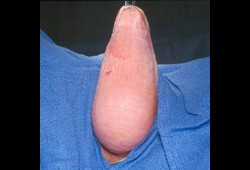Resumo
Definição
História e exame físico
Principais fatores diagnósticos
- vaginal protrusion/bulge
- sensation of vaginal pressure
Outros fatores diagnósticos
- urinary incontinence
- defecatory dysfunction
- pelvic pain
- voiding dysfunction
- sexual dysfunction
Fatores de risco
- vaginal delivery
- advancing age
- obesity
- previous surgery for prolapse
- genetic factors
- white ancestry
- connective tissue disorders
- increased intra-abdominal pressure
Investigações diagnósticas
Primeiras investigações a serem solicitadas
- assessment of postvoid residual urine (PVR) volume
- urinalysis
Investigações a serem consideradas
- urodynamics
Algoritmo de tratamento
asymptomatic
symptomatic
Colaboradores
Autores
Lior Lowenstein, MD, MS, MHA, MBA

Associate Clinical Professor and Head of Gynecology Division
Rambam Health Care Campus
Rappaport Faculty of Medicine
Technion-Israel Institute of Technology
Haifa
Israel
Declarações
LL declares that he has no competing interests.
Omer Anis, MD
Urology Department
Chaim-Sheba Medical Center
Tel Aviv
Israel
Declarações
OA declares that she has no competing interests.
Agradecimentos
Dr Lior Lowenstein and Dr Omer Anis would like to thank Dr Linda Brubaker, a previous contributor to this topic.
Declarações
LB has received editorial honoraria from JAMA, UpToDate, and the Female Pelvic Medicine and Reconstructive Surgery journal. LB is an author of some of the references cited in this topic.
Revisores
Sarah Collins, MD
Associate Professor of Obstetrics and Gynecology
Northwestern University
Feinberg School of Medicine
Chicago
IL
Declarações
SC declares that she has no competing interests.
Sushma Srikrishna, MRCOG
Locum Consultant Urogynaecologist and Obstetrician
Kings College Hospital
London
UK
Declarações
SS declares that she has no competing interests.
Créditos aos pareceristas
Os tópicos do BMJ Best Practice são constantemente atualizados, seguindo os desenvolvimentos das evidências e das diretrizes. Os pareceristas aqui listados revisaram o conteúdo pelo menos uma vez durante a história do tópico.
Declarações
As afiliações e declarações dos pareceristas referem--se ao momento da revisão.
Referências
Principais artigos
American College of Obstetricians and Gynecologists. Practice bulletin no. 214: pelvic organ prolapse. Nov 2019 [internet publication].Texto completo
Winters JC, Dmochowski RR, Goldman HB, et al; American Urological Association; Society of Urodynamics, Female Pelvic Medicine & Urogenital Reconstruction. Urodynamic studies in adults: AUA/SUFU guideline. J Urol. 2012 Dec;188(6 Suppl):2464-72. Resumo
National Institute for Health and Care Excellence. Urinary incontinence and pelvic organ prolapse in women: management. Jun 2019 [internet publication].Texto completo
Maher C, Feiner B, Baessler K, et al. Surgery for women with anterior compartment prolapse. Cochrane Database Syst Rev. 2016 Nov 30;(11):CD004014.Texto completo Resumo
Baessler K, Christmann-Schmid C, Maher C, et al. Surgery for women with pelvic organ prolapse with or without stress urinary incontinence. Cochrane Database Syst Rev. 2018 Aug 19;(8):CD013108.Texto completo Resumo
Brubaker L, Cundiff GW, Fine P, et al; Pelvic Floor Disorders Network. Abdominal sacrocolpopexy with Burch colposuspension to reduce urinary stress incontinence. N Engl J Med. 2006 Apr 13;354(15):1557-66.Texto completo Resumo
Artigos de referência
Uma lista completa das fontes referenciadas neste tópico está disponível para os usuários com acesso total ao BMJ Best Practice.

Diagnósticos diferenciais
- Cervical elongation
- Vaginal cyst
- Gynecologic cancer
Mais Diagnósticos diferenciaisDiretrizes
- Non-neurogenic female LUTS
- AAGL practice report: practice guidelines on the prevention of apical prolapse at the time of benign hysterectomy
Mais DiretrizesConectar-se ou assinar para acessar todo o BMJ Best Practice
O uso deste conteúdo está sujeito ao nosso aviso legal